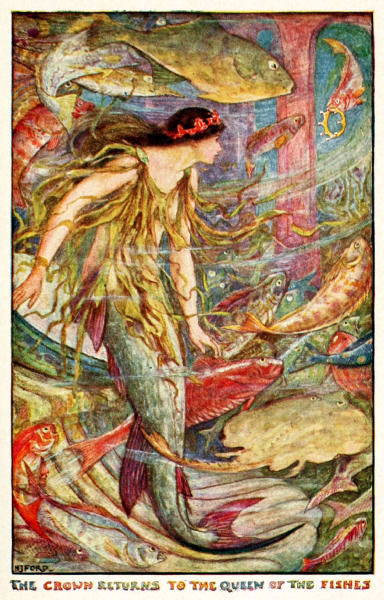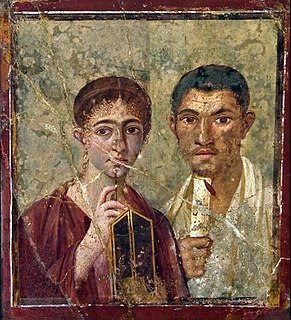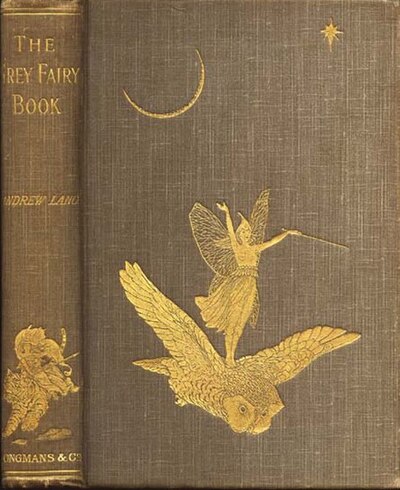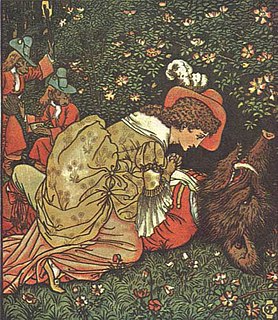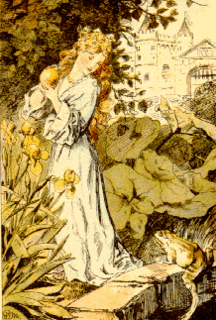 Rumpelstiltskin from The Blue Fairy Book, by Henry J. Ford | |
The Blue Fairy Book The Red Fairy Book The Blue Poetry Book The Green Fairy Book The True Story Book The Yellow Fairy Book The Red True Story Book The Animal Story Book The Pink Fairy Book The Arabian Nights' Entertainments The Red Book of Animal Stories The Grey Fairy Book The Violet Fairy Book The Book of Romance The Crimson Fairy Book The Brown Fairy Book The Red Romance Book The Orange Fairy Book The Olive Fairy Book The Red Book of Heroes The Lilac Fairy Book The All Sorts of Stories Book The Book of Saints and Heroes The Strange Story Book | |
| Author | Andrew Lang |
|---|---|
| Illustrator | Henry J. Ford (and others) |
| Language | English |
| Genre | Fairy tales |
| Published | 1889–1913 |
| No. of books | 25 |
The Langs' Fairy Books are a series of 25 collections of true and fictional stories for children published between 1889 and 1913. The best known books of the series are the 12 collections of fairy tales also known as Andrew Lang's "Coloured" Fairy Books or Andrew Lang's Fairy Books of Many Colors. In all, the volumes feature 798 stories, besides the 153 poems in The Blue Poetry Book.
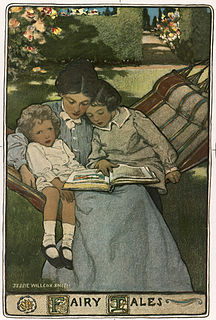
Children's literature or juvenile literature includes stories, books, magazines, and poems that are enjoyed by children. Modern children's literature is classified in two different ways: genre or the intended age of the reader.
This article presents lists of literary events and publications in 1889.
This article presents lists of the literary events and publications in 1913.
Contents
- The Fairy Books
- Origin and influence
- Sources
- Books
- The Blue Fairy Book (1889)
- The Red Fairy Book (1890)
- The Blue Poetry Book (1891)
- The Green Fairy Book (1892)
- The True Story Book (1893)
- The Yellow Fairy Book (1894)
- The Red True Story Book (1895)
- The Animal Story Book (1896)
- The Pink Fairy Book (1897)
- The Arabian Nights' Entertainments (1898)
- The Red Book of Animal Stories (1899)
- The Grey Fairy Book (1900)
- The Violet Fairy Book (1901)
- The Book of Romance (1902)
- The Crimson Fairy Book (1903)
- The Brown Fairy Book (1904)
- The Red Romance Book (1905)
- The Orange Fairy Book (1906)
- The Olive Fairy Book (1907)
- The Book of Princes and Princesses (1908)
- The Red Book of Heroes (1909)
- The Lilac Fairy Book (1910)
- The All Sorts of Stories Book (1911)
- The Book of Saints and Heroes (1912)
- The Strange Story Book (1913)
- References
- External links
Andrew Lang (1844–1912) was a Scots poet, novelist, and literary critic. He initially edited the series and wrote prefaces for its entire run, while his wife, the translator and author Leonora Blanche Alleyne, known to friends and family as Nora, assumed editorial control of the series in the 1890s [1] . She and other translators did a large portion of the translating and retelling of the actual stories, as acknowledged in the prefaces. Four of the volumes from 1908 to 1912 were published by "Mrs. Lang".

Andrew Lang was a Scottish poet, novelist, literary critic, and contributor to the field of anthropology. He is best known as a collector of folk and fairy tales. The Andrew Lang lectures at the University of St Andrews are named after him.

The Scottish people or Scots, are a nation and Celtic ethnic group native to Scotland. Historically, they emerged from an amalgamation of two Celtic-speaking peoples, the Picts and Gaels, who founded the Kingdom of Scotland in the 9th century. Later, the neighbouring Celtic-speaking Cumbrians, as well as Germanic-speaking Anglo-Saxons and Norse, were incorporated into the Scottish nation.

A poet is a person who creates poetry. Poets may describe themselves as such or be described as such by others. A poet may simply be a writer of poetry, or may perform their art to an audience.
According to Anita Silvey, "The irony of Lang's life and work is that although he wrote for a profession—literary criticism; fiction; poems; books and articles on anthropology, mythology, history, and travel ... he is best recognized for the works he did not write." [2]
Anita Silvey is a editor and literary critic in the genre of children’s literature. Born in Fort Wayne, Indiana, Silvey has served as Editor-in-Chief of The Horn Book Magazine and as vice-president at Houghton Mifflin where she oversaw children’s and young adult book publishing. She has also authored a number of critical books about children's literature, including 500 Great Books for Teens and The Essential Guide to Children's Books and Their Creators. In October 2010, she began publishing the Children's Book-A-Day Almanac on line, a daily essay on classic and contemporary children's books.
Anthropology is the scientific study of humans and human behavior and societies in the past and present. Social anthropology and cultural anthropology study the norms and values of societies. Linguistic anthropology studies how language affects social life. Biological or physical anthropology studies the biological development of humans.
The genre of travel literature encompasses outdoor literature, guide books, nature writing, and travel memoirs.
The 12 Coloured Fairy Books were illustrated by H. J. Ford (Henry Justice Ford)—the first two volumes shared with G. P. Jacomb-Hood and Lancelot Speed respectively, and the sequels alone. [3] A. Wallis Mills also contributed some illustrations.

Henry Justice Ford (1860–1941) was a prolific and successful English artist and illustrator, active from 1886 through to the late 1920s. Sometimes known as H. J. Ford or Henry J. Ford, he came to public attention when he provided the numerous beautiful illustrations for Andrew Lang's Fairy Books, which captured the imagination of a generation of British children and were sold worldwide in the 1880s and 1890s.

Lancelot Speed was a British illustrator of books in the Victorian era, usually of a fantastical or romantic nature. He is probably most well known for his illustrations for Andrew Lang's fairy story books. Speed is credited as the designer on the 1916 silent movie version of the novel She by H. Rider Haggard, which he had illustrated.
